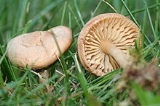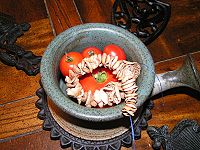
Marasmius oreades
Encyclopedia
Marasmius oreades is also known as the scotch bonnet or fairy ring mushroom. The latter name tends to cause some confusion, as many other mushrooms grown in fairy ring
s (such as the edible Agaricus campestris
, the poisonous Chlorophyllum molybdites
, and many others).
, which causes the grass to grow and become greener). The cap is 1-5 cm across; bell-shaped with a somewhat inrolled margin at first, becoming broadly convex with an even or uplifted margin, but often retaining a slight central bump; dry; smooth; pale tan or buff, occasionally white, or reddish tan; usually changing color markedly as it dries out; the margin sometimes faintly lined.
The bare, pallid stem grows up to about 7cm by 5mm in diameter.
The gills are attached to the stem or free from it, fairly distant (rather a distinctive character), and white or pale tan, dropping a white spore-print. The spores, themselves, are 7-10 x 4-6 µ; smooth; elliptical; inamyloid. Cystidia absent. Pileipellis without broom cells.
This mushroom can be mistaken for the toxic Clitocybe dealbata
which lacks an umbo
, is white to grey in color, and has closely spaced decurrent gills.
 Many mushroom connoisseurs are fond of M. oreades and its sweet taste lends it to baked goods such as cookies. It is also used in foods such as soups, stews, etc. Traditionally, the stems (which tend to be fibrous and unappetizing) are cut off and the caps are threaded and dried in strings. The reason why this mushroom is so sweet-tasting is due to the presence of trehalose
Many mushroom connoisseurs are fond of M. oreades and its sweet taste lends it to baked goods such as cookies. It is also used in foods such as soups, stews, etc. Traditionally, the stems (which tend to be fibrous and unappetizing) are cut off and the caps are threaded and dried in strings. The reason why this mushroom is so sweet-tasting is due to the presence of trehalose
, a type of sugar that allows M. oreades to cheat death. When exposed to water after being completely dried out, the trehalose is digested as the cells completely revive, causing cellular reproduction and the creation of new spore
s to pick up again.
Fairy ring
A fairy ring, also known as fairy circle, elf circle, elf ring or pixie ring, is a naturally occurring ring or arc of mushrooms. The rings may grow to over in diameter, and they become stable over time as the fungus grows and seeks food underground. They are found mainly in forested areas, but...
s (such as the edible Agaricus campestris
Agaricus campestris
Agaricus campestris is commonly known as the field mushroom or, in North America, meadow mushroom. It is a widely eaten gilled mushroom closely related to the cultivated button mushroom Agaricus bisporus.-Taxonomy:...
, the poisonous Chlorophyllum molybdites
Chlorophyllum molybdites
Chlorophyllum molybdites, which has the common names of false parasol or green-spored parasol is a widespread mushroom. Highly poisonous and producing severe gastrointestinal symptoms of vomiting and diarrhea, it is commonly confused with the shaggy parasol, and is the most commonly consumed...
, and many others).
Distribution and habitat
Marasmius oreades grows extensively throughout North America and Europe in the summer and fall, or year-round in warmer climates. It loves grassy areas such as lawns, meadows, and even dunes in coastal areas.Description
It grows gregariously in troops, arcs, or rings (type IIFairy ring
A fairy ring, also known as fairy circle, elf circle, elf ring or pixie ring, is a naturally occurring ring or arc of mushrooms. The rings may grow to over in diameter, and they become stable over time as the fungus grows and seeks food underground. They are found mainly in forested areas, but...
, which causes the grass to grow and become greener). The cap is 1-5 cm across; bell-shaped with a somewhat inrolled margin at first, becoming broadly convex with an even or uplifted margin, but often retaining a slight central bump; dry; smooth; pale tan or buff, occasionally white, or reddish tan; usually changing color markedly as it dries out; the margin sometimes faintly lined.
The bare, pallid stem grows up to about 7cm by 5mm in diameter.
The gills are attached to the stem or free from it, fairly distant (rather a distinctive character), and white or pale tan, dropping a white spore-print. The spores, themselves, are 7-10 x 4-6 µ; smooth; elliptical; inamyloid. Cystidia absent. Pileipellis without broom cells.
This mushroom can be mistaken for the toxic Clitocybe dealbata
Clitocybe dealbata
Clitocybe dealbata, also known as the ivory funnel, is a small white funnel-shaped toadstool widely found in lawns, meadows and other grassy areas in Europe and North America. Also known as the sweating mushroom, it derives this name from the symptoms of poisoning...
which lacks an umbo
Umbo (mycology)
thumb|right|[[Cantharellula umbonata]] has an umbo.thumb|right|The cap of [[Psilocybe makarorae]] is acutely papillate.An umbo is a raised area in the center of a mushroom cap. Caps that possess this feature are called umbonate. Umbos that are sharply pointed are called acute, while those that are...
, is white to grey in color, and has closely spaced decurrent gills.
Edibility

Trehalose
Trehalose, also known as mycose or tremalose, is a natural alpha-linked disaccharide formed by an α,α-1,1-glucoside bond between two α-glucose units. In 1832, H.A.L. Wiggers discovered trehalose in an ergot of rye, and in 1859 Marcellin Berthelot isolated it from trehala manna, a substance made...
, a type of sugar that allows M. oreades to cheat death. When exposed to water after being completely dried out, the trehalose is digested as the cells completely revive, causing cellular reproduction and the creation of new spore
Spore
In biology, a spore is a reproductive structure that is adapted for dispersal and surviving for extended periods of time in unfavorable conditions. Spores form part of the life cycles of many bacteria, plants, algae, fungi and some protozoa. According to scientist Dr...
s to pick up again.

